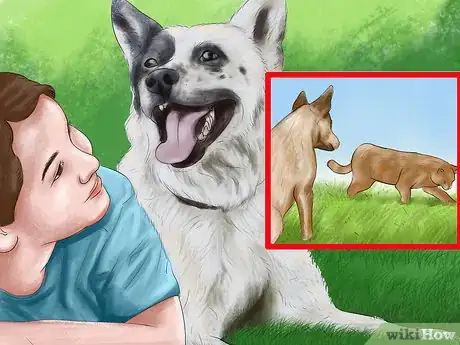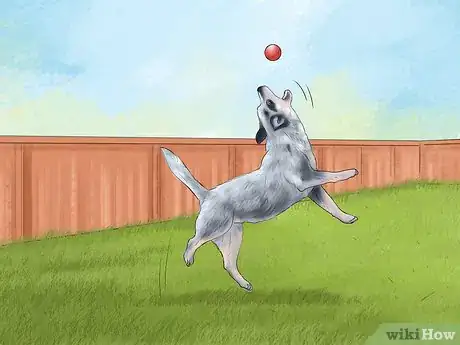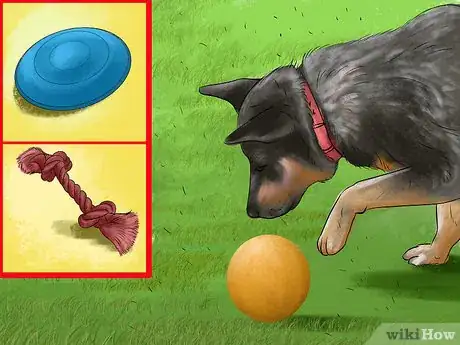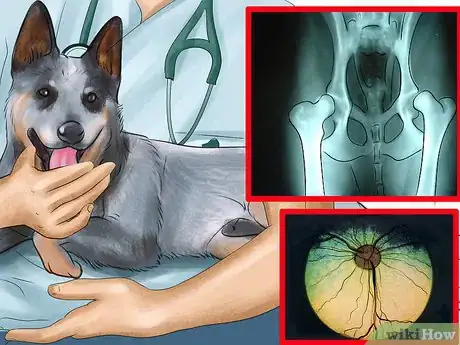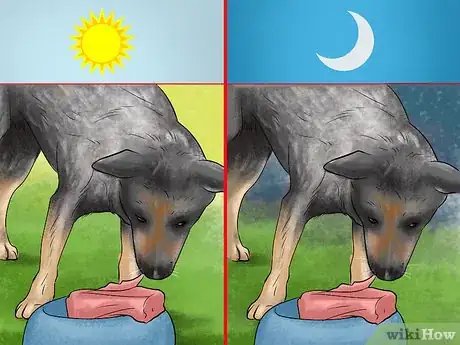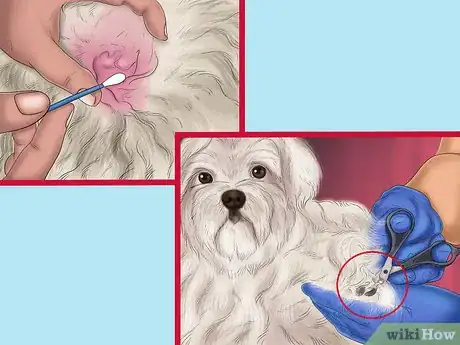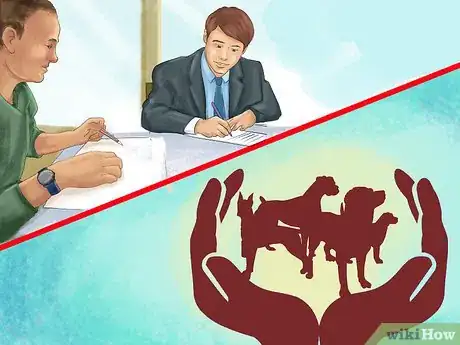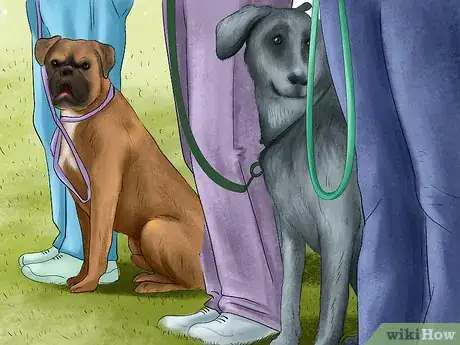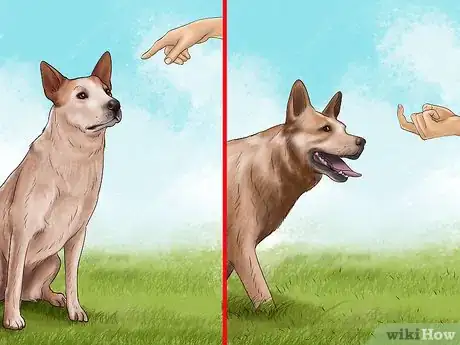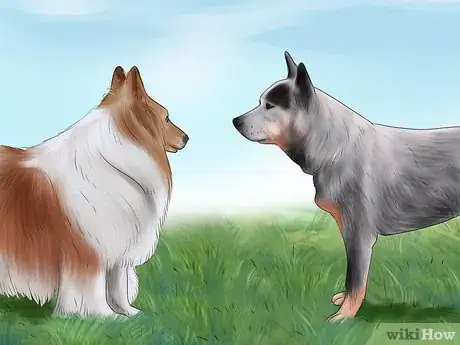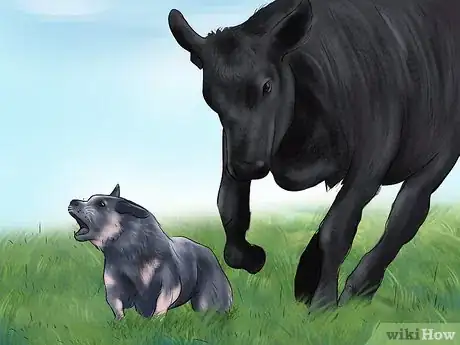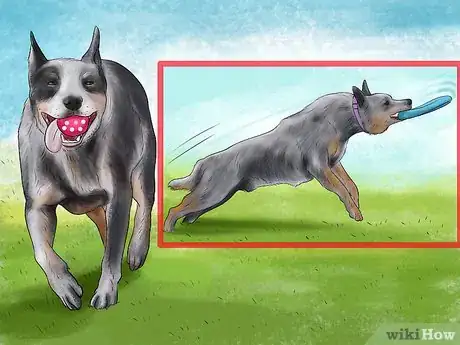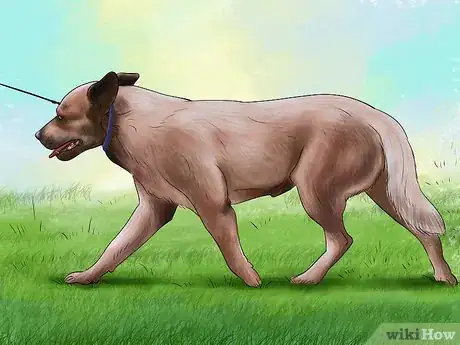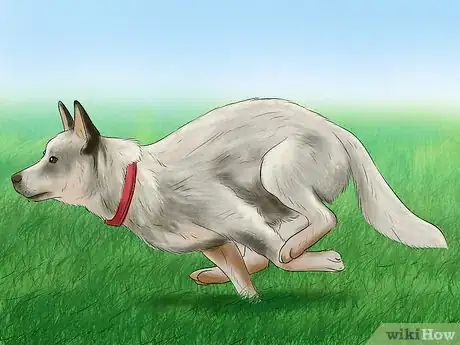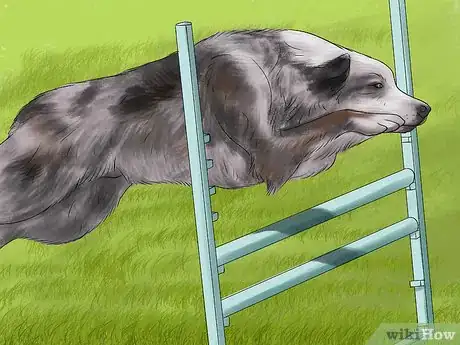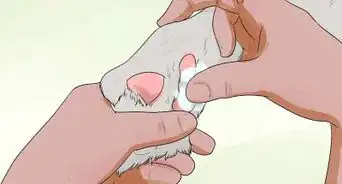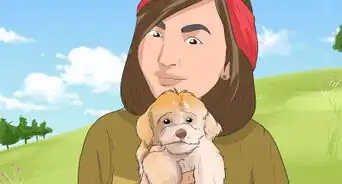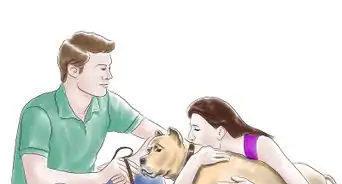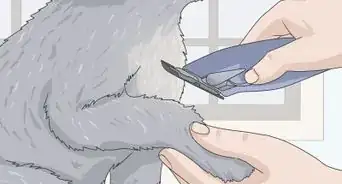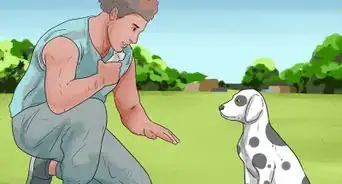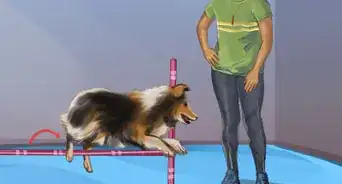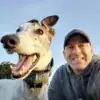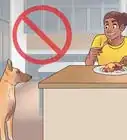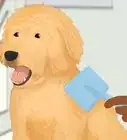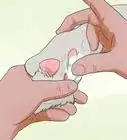This article was co-authored by Brad Greene. Brad is a Certified Professional Dog Trainer (CPDT-KA) and a Fear Free Certified Professional. He is the owner of Fearless Dogs, which is based in the Bay Area of California and has a 5-star rating. Brad specializes in helping clients and their dogs work through challenges using effective and humane behavior change methods, enabling their relationship to thrive. His greyhound, Asher was featured in Greyhound Rescue’s 2022 calendar.
There are 17 references cited in this article, which can be found at the bottom of the page.
This article has been viewed 36,164 times.
Australian Cattle Dogs, also known as Blue Heelers, are very intelligent, versatile, and active dogs. They are both excellent and effective working cattle dogs and extraordinarily family pets. They do require special care, however, to accommodate their high energy needs and protective characteristics. Training may be a lifelong process with Australian Cattle Dogs, as they can be both intelligent and stubborn. Make sure they have plenty of social, physical, and mental activity to prevent them from becoming bored and destructive. If you can keep up with their active lifestyles, Australian Cattle Dogs are extremely loving pets who will stand by their family’s side for their whole lives.
Steps
Bringing an Australian Cattle Dog Home
-
1Introduce them slowly to children and pets. Cattle dogs can learn to live with children and pets, but they should be given time and space to adjust. When you first bring your cattle dog home, separate them from other animals and children with a baby gate. This will allow the other pets to get used to their presence and smell before they are left alone with one another.
- Cattle dogs may have an instinct to chase or herd your cat. While many do live successfully with cats, always make sure that your cat has somewhere in the house to escape to where the dog cannot reach them. Supervise your cattle dog and your cat for the first few weeks. If your dog tries to mouth or chase the cat, distract them with a toy.[1]
- If you have another dog in the house, you should introduce them outside while they are both leashed. Slowly walk them towards one another, and if they do not react aggressively, you can try taking them on a walk side by side. Inside the house, you may need to keep them separate for the first few weeks.
- Always teach your children how to properly act around a dog. You may notice your cattle dog trying to herd your children, especially if your children are running around.[2]
- Make sure to always supervise interactions with kids to be sure that everyone is safe and having fun.
-
2Provide a yard. If you are adopting a cattle dog, you will need to provide a fenced yard for them to play in. Cattle dogs are extremely high energy dogs, and daily walks are not sufficient to exercise them. In a small home or apartment, the dog may grow restless and misbehave.Advertisement
-
3Buy your cattle dog plenty of toys. Australian Cattle Dogs need mental as well as physical stimulation. Toys can provide both, keeping your cattle dog busy and out of trouble. Good toys include chew toys, food puzzles, stuffed animals, balls, Frisbees, rope toys, and rawhide bones.[3]
- Playing can help redirect the dog’s attention to a desired activity and increase fatigue, keeping your dog well-behaved.
-
4Take them to the vet. You should have a reliable vet who can screen your cattle dog for health problems and provide routine care and checkups. When you first adopt your cattle dog, make sure that they have all of their vaccinations. Certain health problems are more common in Australian Cattle Dogs, and you should be prepared to care for your dog if these develop.
- Hip dysplasia is a deformity that can cause arthritis and joint disease in dogs.[4]
- Patellar luxation is a dislocation of the kneecap. Surgery may be required to treat it.[5]
- Portosystemic shunts is caused by a deformity of the blood vessels in the liver. It can cause growth problems, seizures, or strange behaviors such as circling or head pressing. This is a congenital problem that can be treated with diet, medication, or surgery.[6]
- Progressive retinal atrophy (PRA) causes the dog to gradually lose their sight. It is a genetic disease.[7]
- Genetic deafness can also occur.[8]
- Unless you are seriously considering breeding your purebred Australian Cattle Dog, you should also have them spayed or neutered.
Fulfilling Your Dog’s Needs
-
1Feed twice a day. Choose a nutritious brand of dog food that caters to medium sized dogs.[9] Try to find a brand that does not contain many fillers, such as corn meal, bran, or brewer’s rice.
- You can make your cattle dog work for their food. This will keep them busy and provide stimulation. Hide your dog’s food around the house and make them hunt for it. You can also put food or treats inside food puzzle toys.[10]
- You should also have a water bowl set out for them. Make sure that there is always clean, fresh water available, and change the water daily. If you live somewhere hot, you may even want to set a bowl outside for your dog.
-
2Groom them. Australian Cattle Dogs have a double coat that repels dirt. You only need to brush the dog once a week with a bristle or slicker brush. Twice a year, when the dog is shedding, you may have to brush more frequently. Cattle dogs only need to be bathed when they have become visibly dirty.[11]
- Check your dog’s ears often for signs of ear wax. If your dog is pawing at their ears or whining when you touch their ears, you may want to have them checked out by a vet.
- You should trim your dog’s nails regularly. If the dog’s nails are tapping against the floor, they are too long.
-
3Avoid leaving the cattle dog alone for long periods of time. Australian Cattle Dogs are known to be especially close to their owners, but this means that they are susceptible to separation anxiety. Cattle dogs should not be left alone or confined for long periods of time.[12]
- If you work during the day, you may want to see if a dog sitter, friend, or family member can visit the dog while you’re at work. You might also consider coming home during your lunch break.
Training Your Australian Cattle Dog
-
1Enroll your dog in an obedience class. Australian cattle dogs are highly intelligent dogs, and they require consistent and strong leadership to be trained. If you do not enforce consistent rules in the household, the dog may misbehave. Obedience classes can help teach you how to keep your cattle dog in line while teaching them basic rules.
- For puppies, there are special classes that will instruct them from a young age. No puppy is too young to begin training, although many training schools will require your puppy to have certain vaccinations before they can attend.
- For working cattle dogs, lessons with an experienced cattle dog trainer is advised.
- Some people find that clicker training works well with cattle dogs.[13]
-
2Teach them basic commands. Certain basic commands will help you communicate with your cattle dog. These commands include “sit,” “come,” “lay down, and “stay.” Show your dog the proper behavior, and reward them when they successfully do it. Soon they will associate the word with the command.[14]
- If you are training a working dog, you may also need to teach them special commands such as “come by,” “away to me,” and “look back.” For cattle dogs, the ability to herd is instinctual, and they may only need commands to make them perform certain actions.
-
3Socialize them while they are young. Cattle dogs are extremely loyal to their families, but they can be shy or aggressive towards strangers. As early as possible, expose your cattle dog to strangers and other animals.
- Take your cattle dog on as many car trips as you can. This will let them experience a variety of sights, sounds, smells, and people in a safe environment.
- Leashed walks can also help your cattle dog grow used to other people and animals.
- Once your cattle dog has been exposed to a few other dogs without incident, you can try taking them to a dog park, where they can run and play with other dogs.
- While cattle dogs can be very protective and loyal to children in their family, they may not react well to stranger’s children.[15]
-
4Discourage mouthing or nipping. Australian Cattle Dogs have an instinct to nip livestock as they herd them. In a household, this means that your cattle dog may try to mouth you. While this is natural behavior, you should discourage it.[16] When your cattle dog nips you, say “no” and walk away. Ignore them for a few minutes before returning. They will soon learn that nipping is a bad behavior.
- If your dog starts mouthing you, give them a chew toy instead. This will teach them to get their urges out on the toy and not on you.[17]
- Do not hit or yell at your dog for nipping. By responding aggressively to natural behavior, you are only teaching them to fear you.
Exercising Your Australian Cattle Dog
-
1Play with them. Interactive games are important to helping your cattle dog get rid of their excess energy. Such games increase the bond between you and your dog, and they are an important part of the socialization process. Some good games you can play include:
- Hide and seek
- Fetch
- Catch with a Frisbee
- Tug-of-War
-
2Take them for long walks. Your cattle dog needs plenty of exercise. While some breeds will be content with one or two walks around the block, cattle dogs need long walks at least once or twice a day.[18] This will help make your cattle dog nice and tired, preventing them from getting bored or mischievous.
- If you are a runner, you might consider taking your cattle dog on a run with you. This is a great way to get the proper amount of exercise for your dog.
-
3Let them run off the leash. While leashed walks are important, your cattle dog should have the opportunity to run off the leash as well. In a fenced yard or park, let them run and play freely. They may enjoy playing with other dogs at a dog park or merely playing alone in their backyard.
-
4Take them to an agility class. Agility classes offer structured games, activities, and obstacle courses that are fun for both you and your dog. Because of their natural agility and high energy, cattle dogs are ideal for agility courses.[19]
- You can find local agility classes online, through your vet, or through your obedience training school.
Expert Q&A
-
QuestionAre Blue Heeler Dogs aggressive?
 Pippa Elliott, MRCVSDr. Elliott, BVMS, MRCVS is a veterinarian with over 30 years of experience in veterinary surgery and companion animal practice. She graduated from the University of Glasgow in 1987 with a degree in veterinary medicine and surgery. She has worked at the same animal clinic in her hometown for over 20 years.
Pippa Elliott, MRCVSDr. Elliott, BVMS, MRCVS is a veterinarian with over 30 years of experience in veterinary surgery and companion animal practice. She graduated from the University of Glasgow in 1987 with a degree in veterinary medicine and surgery. She has worked at the same animal clinic in her hometown for over 20 years.
Veterinarian Blue Heelers are not overtly aggressive, but they do use their mouth as a tool and won't suffer fools gladly. A well-socialized dog can be taught bite inhibition and learn not to be mouthy, but a working dog may well nip to get their point across.
Blue Heelers are not overtly aggressive, but they do use their mouth as a tool and won't suffer fools gladly. A well-socialized dog can be taught bite inhibition and learn not to be mouthy, but a working dog may well nip to get their point across. -
QuestionDo Australian Cattle Dogs need a lot of exercise?
 Pippa Elliott, MRCVSDr. Elliott, BVMS, MRCVS is a veterinarian with over 30 years of experience in veterinary surgery and companion animal practice. She graduated from the University of Glasgow in 1987 with a degree in veterinary medicine and surgery. She has worked at the same animal clinic in her hometown for over 20 years.
Pippa Elliott, MRCVSDr. Elliott, BVMS, MRCVS is a veterinarian with over 30 years of experience in veterinary surgery and companion animal practice. She graduated from the University of Glasgow in 1987 with a degree in veterinary medicine and surgery. She has worked at the same animal clinic in her hometown for over 20 years.
Veterinarian Oh, yes, Australian Cattle Dogs are definitely energetic, and designed to be active all day long. To not provide enough exercise will lead to boredom, which may show itself in inappropriate behaviors such as barking, digging, or destructiveness.
Oh, yes, Australian Cattle Dogs are definitely energetic, and designed to be active all day long. To not provide enough exercise will lead to boredom, which may show itself in inappropriate behaviors such as barking, digging, or destructiveness. -
QuestionAre Australian Cattle Dogs good family pets?
 Pippa Elliott, MRCVSDr. Elliott, BVMS, MRCVS is a veterinarian with over 30 years of experience in veterinary surgery and companion animal practice. She graduated from the University of Glasgow in 1987 with a degree in veterinary medicine and surgery. She has worked at the same animal clinic in her hometown for over 20 years.
Pippa Elliott, MRCVSDr. Elliott, BVMS, MRCVS is a veterinarian with over 30 years of experience in veterinary surgery and companion animal practice. She graduated from the University of Glasgow in 1987 with a degree in veterinary medicine and surgery. She has worked at the same animal clinic in her hometown for over 20 years.
Veterinarian Although affectionate to those they know and trust, Australian Cattle Dogs can sometimes be unpredictable around kids, especially those they don't know well. Also, their herding instinct means they can sometimes nip at the heels of children, as if to round them up, which some youngsters find distressing.
Although affectionate to those they know and trust, Australian Cattle Dogs can sometimes be unpredictable around kids, especially those they don't know well. Also, their herding instinct means they can sometimes nip at the heels of children, as if to round them up, which some youngsters find distressing.
Warnings
- Cattle dogs may be protective over their food. Do not interrupt them while they are eating.⧼thumbs_response⧽
- Because of their high intelligence, cattle dogs are known to try to dominate the household. Consistency is the most important thing while training, and it must be maintained throughout their entire lifetime. Always reward for the same behaviors, and do not encourage bad behaviors.[23]⧼thumbs_response⧽
Expert Interview
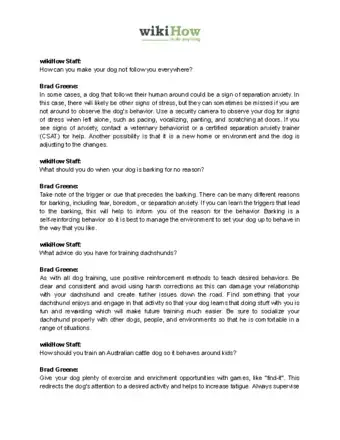
Thanks for reading our article! If you'd like to learn more about pet caring, check out our in-depth interview with Brad Greene.
References
- ↑ http://www.acdra.org/frequently-asked-questions
- ↑ http://www.acdra.org/living-with-an-acd
- ↑ http://www.humanesociety.org/animals/dogs/tips/dog_toys.html?credit=web_id101199907
- ↑ http://www.vcahospitals.com/main/pet-health-information/article/animal-health/hip-dysplasia-in-dogs/783
- ↑ https://www.acvs.org/small-animal/patellar-luxations
- ↑ http://www.vet.utk.edu/clinical/sacs/shunt/faq.php
- ↑ http://www.vetstreet.com/progressive-retinal-atrophy-in-dogs
- ↑ http://www.vetstreet.com/dogs/australian-cattle-dog#health
- ↑ http://www.akc.org/dog-breeds/australian-cattle-dog/care/#feeding
- ↑ http://www.acdra.org/frequently-asked-questions
- ↑ http://www.vetstreet.com/dogs/australian-cattle-dog#grooming
- ↑ http://www.acdra.org/living-with-an-acd
- ↑ http://www.acdra.org/living-with-an-acd
- ↑ https://www.mspca.org/pet_resources/teaching-your-dog-the-basics/
- ↑ http://www.acdra.org/living-with-an-acd
- ↑ http://www.vetstreet.com/dogs/australian-cattle-dog#personality
- ↑ http://www.aspca.org/pet-care/dog-care/common-dog-behavior-issues/mouthing-nipping-and-play-biting-adult-dogs
- ↑ http://www.acdra.org/frequently-asked-questions
- ↑ http://www.akc.org/events/agility/what-is-agility/
- ↑ http://www.acdra.org/living-with-an-acd
- ↑ http://petcha.com/pets/breed/australian-cattle-dog/
- ↑ http://images.akc.org/pdf/breeds/standards/AustralianCattleDog.pdf?_ga=1.17632572.488211752.1475700086
- ↑ http://www.acdra.org/living-with-an-acd
About This Article
To care for an Australian cattle dog, make sure you have a yard for your dog to play in since they’re a high-energy breed that needs more than daily walks for exercise. Try and play interactive games with it like fetch and tug-of-war, and when you can, let your pup run off leash. You should also give it lots of toys to stimulate its mind, such as food puzzles, balls, and rope toys. Since Australian cattle dogs are prone to separation anxiety, don’t leave your dog alone or confined for long periods of time. For more tips from our Veterinary co-author, including how to train your Australian cattle dog, scroll down!
